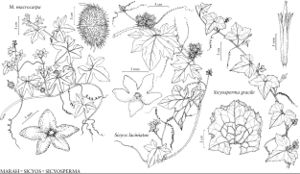Sicyos
Sp. Pl. 2: 1013. 1753.
Gen. Pl. ed. 5, 443. 1754.
| Taxon | Illustrator ⠉ | |
|---|---|---|
 | Marah macrocarpa Sicyos laciniatus Sicyosperma gracile | Yevonn Wilson-Ramsey Yevonn Wilson-Ramsey Yevonn Wilson-Ramsey |
Plants annual, monoecious, climbing or trailing; stems glabrous or hairy, often viscid-pubescent when young; roots fibrous; tendrils 2–5-branched from a common point. Leaves sessile or subsessile to petiolate; blade ovate or orbiculate to suborbiculate or reniform, deeply to shallowly palmately 3–5-angular-lobed, lobes triangular to deltate, margins usually serrate to denticulate, surfaces eglandular. Inflorescences: staminate flowers 3–22 (–34) in axillary racemes or panicles; pistillate flowers 4–16, sessile to subsessile in umbelliform clusters at peduncle apex, from same axils as staminate, peduncles erect at apex; bracts absent. Flowers: hypanthium cupulate to shallowly campanulate; sepals 5, ovate to deltate or subulate, linear, linear-triangular, or narrowly triangular; petals 5, connate 1/4–1/2 length, white to greenish white, yellowish green, or yellow, triangular to lanceolate or narrowly lanceolate, 0.5–1.5 mm, glabrous abaxially, often glandular adaxially, corolla campanulate to cupulate. Staminate flowers: stamens (2–) 3 (–5); filaments inserted at base of hypanthium, connate 1 mm; thecae connate into head, horseshoe-shaped, connective slightly broadened; pistillodes absent. Pistillate flowers: ovary 1-locular, ovoid-fusiform; ovules 1 per locule; style 1, narrow; stigmas 1, obscurely 2–3-lobed; staminodes absent. Fruits pepos, dark green to gray at maturity, fusiform to ovoid, beaked or not, dry, thin-walled, echinate or spinulose, usually also with shorter hairs, rarely glabrous, indehiscent. Seeds 1, ovoid, compressed, not arillate, margins not differentiated but sometimes with 2 small swellings at base, surface smooth. x = 12.
Distribution
North America, Mexico, Central America, South America, Pacific Islands, Australia, in Europe, e Asia
Discussion
Species ca. 50 (4 in the flora).
Attribution of Sicyos parviflorus A. Gray ex Naudin to the United States has been based on misapplication of the name. The type of S. parviflorus was collected from the vicinity of Mexico City, and the species occurs from central Mexico through Central America into South America (R. Lira 2001).
Selected References
None.
Lower Taxa
Key
| 1 | Pepos ovoid-beaked, 9–15 mm; stigmas 3-lobed; e, c North America, including Texas. | Sicyos angulatus |
| 1 | Pepos ovoid, 4–8 mm; stigmas 2- or 3-lobed; Arizona, New Mexico, Texas | > 2 |
| 2 | Pepos not echinate. | Sicyos glaber |
| 2 | Pepos echinate | > 3 |
| 3 | Staminate inflorescences 10–16-flowered, peduncle plus floral axis 40–140 mm; stigmas 3-lobed; mature stems glabrate to sparsely minutely stipitate-glandular; leaf blades deeply lobed, sinuses (1/3–)1/2–2/3 to base, margins not dentate, evenly sharply indurate-apiculate, proximal pair of lateral veins divergent from edge of basal sinus. | Sicyos microphyllus |
| 3 | Staminate inflorescences 3–10-flowered, peduncle plus floral axis 3–25 mm; stigmas 2-lobed; mature stems glabrescent but remaining villous and stipitate-glandular; leaf blades shallowly lobed to angulate, sinuses 1/5–1/4 to base, margins evenly and shallowly dentate, teeth sharply indurate-apiculate, proximal pair of lateral veins closely bordering edge of basal sinus. | Sicyos laciniatus |